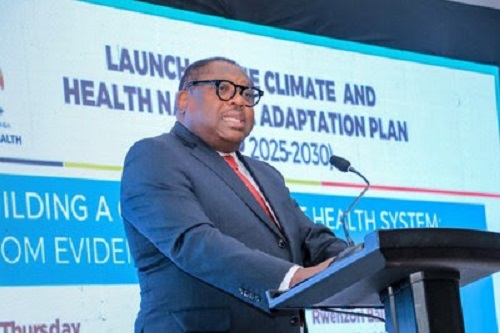
Rockefeller funded research exposes climate related gaps in Uganda’s health future
Kampala, Uganda | PATRICIA AKANKWATSA | As climate change intensifies, Uganda is experiencing severe health consequences, including floods, droughts, and temperature fluctuations. These environmental changes contribute to waterborne diseases, vector-borne illnesses, malnutrition, and mental health problems.
As the Intergovernmental Panel on Climate Change (IPCC) has warned, climate change will increasingly impact the environmental determinants of health. This includes the emergence and re-emergence of infectious diseases, such as Ebola and Malaria, driven by changes in temperature and rainfall patterns. Additionally, climate change damages health infrastructure, disrupts food supply, causes malnutrition, and negatively impacts mental health.
To address these challenges, the Ministry of Health in partnership with Makerere University School of Public Health (MakSPH), launched the Climate and Health National Adaptation Plan (H-NAP) with support from the Rockefeller Foundation and the World Health Organisation (WHO) as a crucial step towards building resilience in the country’s healthcare system.
While speaking at the launch on Aug.22 at Sheraton Kampala Hotel, William Asiko, Vice President and head of The Rockefeller Foundation’s Africa Regional Office, said that climate change poses the most significant threat to the health and well-being of billions of Africans.
“Initiatives like Uganda’s Health National Adaptation Plan demonstrate how African nations are rising to this challenge by implementing necessary climate solutions and setting a global example,”
The H-NAP is informed by a comprehensive Vulnerability and Adaptability Assessment (VAA) conducted across 716 health facilities. The VAA conducted by Makerere University School of Public Health (MakSPH) following the WHO-recommended approach and funded by the Rockefeller Foundation, revealed significant vulnerabilities to various climate hazards, including drought, floods, storms, rising water levels, landslides, lightning, heat waves, and cold waves.
The results from the VAA show that nearly half (48%) of the healthcare facilities face drought, 40% are exposed to floods, 31.1% to storms, 12% to rising water levels, 12% to landslides, 9% to lightning, 2.0% to heat waves, and 0.1% to cold waves. Regional referral hospitals have the least exposure compared to lower-level facilities, which are more vulnerable to storms, high water levels, floods, drought, and landslides.
Also, a significant proportion of facilities lack water safety and management plans to address contamination risks. About 55.1% of facilities exposed to drought and 58.7% exposed to floods lack water safety plans, contingency plans for monitoring and reducing contaminants, and onsite water purification equipment. Additionally, 61% of facilities do not have long-term drought management or emergency water supply plans (59.7% for floods, 66.7% for landslides), highlighting a critical gap in ensuring safe water access during and after hazards.
As for infrastructure, many health facilities in Uganda lack adequate infrastructure to cope with climate hazards, such as stormwater management systems (75.6% for storms) and natural floodwater infiltration systems (68.6% for floods).
The Permanent Secretary at the Ministry of Health Dr. Diana Atwine said that this plan will address the significant threat climate change poses to public health and enhance the resilience of the health sector against climate-related impacts in the country.
“I urge all Ministries, Departments and Agencies to join forces in mitigating the detrimental effects of climate change on both our environment and health,” she stated
“By working collaboratively, we can implement effective strategies to reduce greenhouse gas emissions, protect our natural resources, and ensure that our healthcare systems are equipped to address the health challenges posed by climate change,”
Dr. Herbert Nabaasa, Commissioner in charge of Environmental Health said that the H-NAP is a critical roadmap for building a climate-resilient health system in Uganda.
“By implementing the outlined interventions, we can effectively mitigate the health impacts of climate change and ensure that essential healthcare services remain accessible to all, even in the face of extreme weather events,”
He added that the key interventions include enhancing water and sanitation infrastructure, strengthening disease surveillance, and training healthcare workers on climate-related health issues.
“These measures will help to prevent the spread of waterborne and vector-borne diseases, improve access to clean drinking water, and ensure that healthcare facilities are equipped to respond to the health needs of vulnerable populations,”
The H-NAP outlines strategic interventions aligned with the WHO’s framework and proposes a range of short-term and long-term interventions across ten components: climate-transformative leadership and governance, climate-smart health workforce, integrated risk monitoring, and sustainable financing among others. Specific actions include developing guidelines for mainstreaming climate and health, training health workers, enhancing disease surveillance systems, and revising infrastructure standards for climate-proofing.
 The Independent Uganda: You get the Truth we Pay the Price
The Independent Uganda: You get the Truth we Pay the Price



